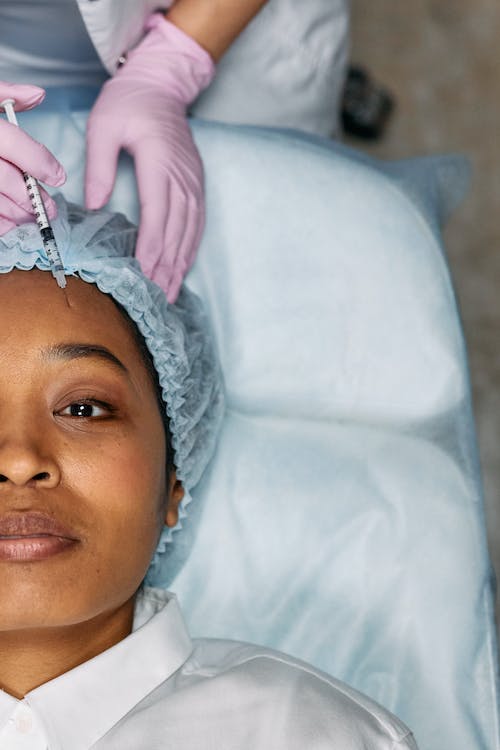What to Expect on Your First Botox Procedure

Botox—a word that once held exclusive residence in Hollywood—has secured a well-earned place in everyday conversations. In 2020 alone, Botox procedures accounted for a significant 48.6% of all non-surgical cosmetic treatments in the United States, totaling over 4.4 million procedures. Botox transcends the cosmetic realm; it resonates with those who value confidence and feeling comfortable in their skin.
The rising popularity of Botox isn’t slowing down. Projected growth for the global Botox market is eye-opening, expected to reach a substantial USD$ 7.79 billion by 2028. Understanding Botox—what it is, its uses, and its impact—has become a topic of high relevance. Whether you’re considering it as a treatment option or simply intrigued by its soaring popularity, shedding light on Botox helps you make informed decisions and engage in knowledgeable conversations.
What is Botox?
Think of Botox as a magic eraser—but for your face. It’s actually a purified protein produced by the bacterium Clostridium botulinum. Don’t be alarmed by the scientific jargon. In simple terms, it relaxes the muscle activity that can lead to deep, persistent lines and wrinkles. The result? A smoother, younger-looking you.
Yet, erasing fine lines and wrinkles is just the tip of the iceberg. Botox is as versatile as it is popular. People flock to clinics to keep migraines at bay, manage excessive sweating, or even to curb teeth grinding—a jack of all trades, really.
So, next time you hear about Botox, you’ll know it’s not just for frown lines and crow’s feet. It’s about much more—it’s about enhancing quality of life.
Preparing for a Botox procedure
Selecting the right clinic and professional for the Botox procedure might seem like a daunting task. The process becomes less intimidating by focusing on qualifications, patient reviews, and a clinic’s reputation. An experienced professional with a solid background in cosmetic procedures is a must.
The initial consultation plays a vital role in a successful Botox experience. This meeting serves as a platform to ask questions such as: What does the professional’s patient history look like? Are before-and-after photos available? How long have they been performing Botox injections? Any hesitation or reluctance to answer such inquiries is a red flag.
Preparation prior to the procedure often entails several straightforward lifestyle adjustments. For example, avoiding blood-thinning medications or supplements, like aspirin or vitamin E, a few days before the procedure can minimize the risk of bruising. Good skincare routine also paves the way for better results.
During the Botox procedure
A Botox session typically follows a step-by-step routine. It begins with a cleanse of the target area to ensure it’s free from makeup and oils. Then, a topical anesthetic might be applied to numb the area, but this is optional and depends on patient and professional preferences. Next comes the main event: the Botox injections. These are administered using a very fine needle, targeting specific muscles.
The length of the procedure is surprisingly brief, often completed within 15-30 minutes. Despite the use of a needle, Botox is generally well tolerated. Some patients report a minor pinch or discomfort at the injection site, but it’s usually fleeting.
Post-Botox procedure
Aftercare following a Botox treatment starts right away. Patients are typically advised to avoid lying down or bending over for a few hours after the procedure. This helps prevent the Botox from migrating to unwanted areas.
In terms of recovery, most people can return to their regular activities immediately. However, strenuous physical activity is usually discouraged for 24 hours following treatment.
Side effects from Botox injections are typically minor and short-lived. These may include bruising, redness, or swelling at the injection site. More serious complications are rare but can include drooping eyelids, uneven smile, or eyebrow asymmetry. If any unusual side effects occur, it is crucial to contact the healthcare provider promptly.
Results and maintenance
Botox may be swift, but patience is key when it comes to seeing results. On average, it takes about 3 to 5 days for the effects to start appearing, with the full impact visible around two weeks after the procedure.
How long do these results last? Botox’s effects are not permanent and typically fade after 3 to 4 months, depending on individual factors such as metabolism, muscle mass, and lifestyle. However, regular follow-up sessions can help maintain the desired effect over time.
In addition to regular sessions, a good skincare routine, including sun protection, hydration, and a balanced diet, can help maintain the skin’s overall health and enhance Botox results.
Common myths and misconceptions about Botox
A handful of myths and misunderstandings surrounding Botox persist, despite its growing popularity. One common fear is that Botox will result in a “frozen” or “emotionless” face. The truth is, when administered correctly by an experienced professional, Botox should smooth wrinkles without affecting natural facial expressions.
Another misconception is that Botox is only for older people. In reality, Botox can be a proactive measure for younger adults to prevent the formation of deep lines over time.
Scientific evidence underscores the safety and effectiveness of Botox. The American Society of Plastic Surgeons (ASPS) notes that side effects are typically minor and temporary, with serious complications rare, especially when performed by a qualified provider. It’s crucial to note that all medical treatments come with some risk, and Botox is no exception. But with the right professional and the proper approach, Botox is considered a safe and effective treatment.
Conclusion
Despite a smattering of myths and misconceptions, scientific evidence upholds the safety and effectiveness of Botox. Yet, like any medical procedure, it’s not devoid of risks. Therefore, the choice to undergo Botox should be made after thorough research and consultation with a trusted professional.
In essence, Botox is not just a cosmetic treatment—it is a reflection of the desire for confidence and comfort in one’s skin. Whether it’s to turn back the clock, alleviate discomfort, or simply to feel good, Botox stands as a testament to advances in the world of cosmetic medicine.

